Last week, I had the honor of helping my Native American friends from the Zia Pueblo in New Mexico plant corn on their tribal land. Every farm has its limiting factors, and for the Zia Pueblo the most prevalent is water. While I’m doing furrow irrigation on my Tennessee farm to utilize and manage our abundance of water, we did the opposite in the New Mexico desert. In the Delta, we hip the soil to create hills and furrows, then plant on top of the hills. Since rain is frequent in the spring, we often plant into moisture, and usually receive rainfall within days of planting, which stimulates emergence. When the crop needs a drink in the summer, we’ll roll out polypipe, pump water from shallow wells through the pipe, poke holes in it, and run water down the furrows. In the spring, when heavy rains are prevalent, planting on the hills prevents the young crop from getting drowned out or wet feet. At the Zia Pueblo, the soil is sandy and very dry. Our water source is melted snow and streams from mountains that feed into a nearby reservoir. Concrete trenches run from the reservoir to the edge of the fields. Growers have access to valves along the trenches, where they can run water to their field. A series of ditches and furrows were dug to move the water throughout our field. We planted our seeds directly in the furrows and ran water down the ditches to irrigate the plants. When the corn reaches about two feet tall, we’ll reverse the system and hip the soil by throwing soil back on the plants to form hills, then we’ll run water down the new furrows where it can be accessed by the roots.
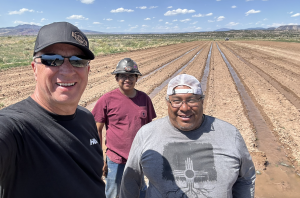
Having the opportunity to grow corn on two vastly different farms is a dream come true, especially working with original masters of corn farming, the Native Americans. Throughout the season, I’ll be journaling crop progress of both farms on this blog. These farms do have a few similarities. Both have very low organic matter, very dedicated farmers and utilize Huma products. But they are vastly different, notably in these key areas:
- Precipitation: My Delta-based farm receives about 60 inches of rain annually; Zia Pueblo gets less than 10.
- Seed: Zia Pueblo is using an heirloom variety – passed down from many generations – for ceremonial and cultural purposes. Upon harvest, they will grind their multi-colored (red, blue, yellow and white) seeds into flour to make tortillas for consumption by the tribal members. On my Delta farm, I planted hybrid seed corn utilizing biotechnology and the most advanced genetics. Upon harvest, the corn will be processed for ethanol or livestock feed.
- Equipment: Zia Pueblo does not have large budgets. Their equipment is small, aged and lacks any technology. The planter is a one-row drum model, spun with a chain, that dispenses seed from two holes. A water truck sprays Huma nutrients across the field. And corn will be harvested by hand. On my Delta farm, tractors and sprayers drive themselves via GPS-guidance systems, and electronics pinpoint seed and crop input placement. We’ll use a combine to mechanically harvest the crop.
- Pesticides: We don’t want to taint the ancestral soil of the Zia Pueblo, so we’re using earth-friendly Huma products to provide all the nutrition. Fortunately, weed pressure is not a big issue, so cultivation can keep any weeds under control. In the Delta, weeds are populous and persistent, so herbicides must be used. I’m also using all Huma products for crop nutrition and to control disease.
I have the utmost admiration and respect for the Zia Pueblo people and how they are growing their crops. They are tremendous farmers. This is the ultimate in “old school farming”, and I love it!
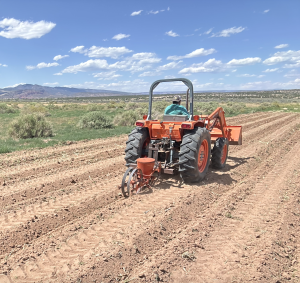
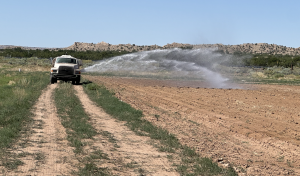
I’ve long believed that crop vigor is key to achieving top-end yields. And so far, my Tennessee farm has it like I’ve never seen before. My corn reached the V5 stage in just 25 days. Sure, 5.5” of rain has been a key contributor, but so have my Huma products and seed genetics. Corn is rapidly coming up on a major milestone, the V6 stage. This is the time when the plant determines the number of rows on the ear. To prepare for this critical stage, last week (at V4) we treated it with Vitol (for plant energy and to push vegetative growth), Lucky 7, Super Nitro, Calcium, Max Pak, X-Tend and Crop Gard. I noticed Johnsongrass while scouting, so we treated it with Steadfast Q, which has a crop safener.
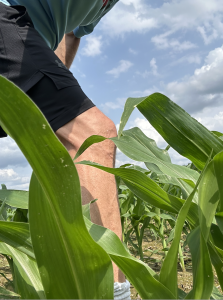

The sports world lost a legend yesterday with the passing of Bill Walton. Arguably the greatest college basketball player of all time (in the 1973 NCAA championship game, he made an astounding 21 of 22 shot attempts!), the big red head went to a successful pro basketball career (and later, was highly entertaining as a broadcaster), albeit greatly hampered due to injury. Bill was a vegetarian. I’ll never forget how my college animal nutrition professor would use Bill as an example for importance of having protein in your diet. He believed Bill’s many foot and leg injuries were due to his plant-only diet, especially when required to support his massive 6’11” frame. Nutritional programs have come a long way in the past 50 years, but I’ve always believed my professor was on to something. Barring injury, it’s no telling how much greater Walton’s Hall of Fame career could have been. Just recently, our Huma team read Coach John Wooden’s “Pyramid of Success” book. While reading it, I couldn’t help thinking how straight-laced Coach Wooden and his Grateful Dead-following, hippie center Walton made the ultimate odd couple while at UCLA. But there’s no denying the love and respect they had for each other, which continued throughout their entire lives. That’s a great lesson we can all take, especially in today’s polarizing world, of how people with vastly different views on life can achieve mutual admiration and genuine fondness for one another.
Related Posts

This Week in Ag #14
You never get a second chance to make a first impression. That popular saying could just as easily apply to planting corn. It’s impossible to recover from planting time mishaps. Don’t believe it? Try this. Walk into a cornfield where plants have recently emerged. Identify a plant that’s shorter than the rest (some call these

This Week in Ag #32
Everyone remembers where they were on September 11, 2001. One of my most vivid memories was the week after. I was farming with my dad at the time. He had just started cutting soybeans in a field owned by my wife’s family, situated next to Interstate 74 in western Illinois. I was driving to the
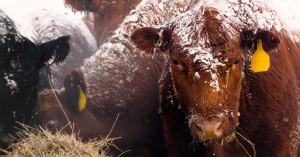
This Week in Ag #48
The popular TV series Yellowstone, along with the western lifestyle craze, has certainly romanticized ranching. It seems like everyone wants to be a rancher, until there’s real-world ranching stuff to do. This week’s bone-chilling Midwestern weather brings back memories. Notice I didn’t say fond memories. When you have livestock, they require care every day. Utility tractors

